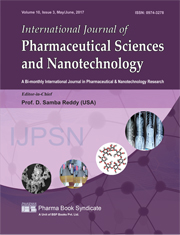Development and Clinical Evaluation of Mucoadhesive Gastroretentive Tablets of Dipyridamole
DOI:
https://doi.org/10.37285/ijpsn.2017.10.3.6Abstract
The present research work was focused to develop a mucoadhesive tablet dosage form for dipyridamole, which shows pH dependent solubility, it is highly soluble in acidic pH and as the pH increases the solubility of the drug decreases. Hence it was selected as the drug candidate for the present research. Mucoadhesive tablets of Dipyridamole were successfully prepared by using polymers like HPMC K4M, Chitosan and Isabgul husk by wet granulation method. FT-IR studies showed that there is no incompatibility between drug, polymer and various excipients used in the formulations. Formulated tablets have shown satisfactory results for physical parameters and complied with the pharmacopeial limits. The ex-vivo mucoadhesive strength and mucoadhesive force was found to be in the range of 16.15- 21.20 g and 1.56-2.06 N. Total ex-vivo mucoadhesive time was observed in between 10 to 12 hours. The in-vitro drug release was found to be more than 90% for the formulations FMD2, FMD3 and FMD8, up to 12 hours. Based on in-vitro drug release and mucoadhesive properties, formulation FMD2 was selected as optimized formulation. The dissolution data were further characterized by fitting the data into various kinetic models. The drug release from the matrices followed zero order with non-fickian release (diffusion + erosion controlled) for the optimized formulation. The optimized formulation was further subjected to swelling studies, which showed a swelling index of 286% up to 24 hours. The results indicated that the selected polymers were of swellable type. The stability studies were carried for 6 months as per ICH and WHO guidelines and the results of the stability study revealed that the optimized formulation is stable during the storage period. The in-vivo radiographic studies in fed condition, for the Mucoadhesive tablets (FMD2) showed a gastric residence time of more than 6 hours. When the radiographic images were taken at different time intervals and it was found to be in a particular location, which suggested that the retention of the dosage form might be due to the adhesion of dosage form to the gastric mucosa.
Downloads
Metrics
Keywords:
Dipyridamole, Mucoadhesive, Radiographic Studies, Chitosan, Isabgul huskDownloads
Published
How to Cite
Issue
Section
References
Amish V panchal, Markand Mehta, Viral H. Shah and Umesh Upadhyay (2012). Formulation and in-vitro evaluation of mucoadhesive bilayered buccal tablets of Rosuvastatin Calcium. IJPSR 3: 2733-2740.
B. R. Mathews (1999). Regulatory aspects of stability testing in Europe. Drug Dev Ind Pharm 25: 831-856.
Bhupinder Singh, Sukhwinder Kaur chakkal and Naveen Ahuja (2006). Formulation and Optimization of Control release Mucoadhesive tablets of Atenolol using Response surface methodology. AAPS Pharm Sci Tech 7: E19-E28.
Deshmukh VN, Harsulkar AA and Sakarkar (2009). Formulation and invitro evaluation of mucoadhesive tablets using hydrophilic gum blends. Int J Pharm Res 1: 16-22.
Doodipala N, Palem CR, Reddy S and Madhusudan Rao. Y (2011). Pharmaceutical Development and Clinical Pharmacokinetic Evaluation of Gastroretentive floating matrix tablets of Levofloxacin. Int J Pharm Sci Nanotech 4: 1461-1467.
Gupta A, Garg S and Khar RK (1993). Measurement of mucoadhesive strength of mucoadhesive buccal tablets: Design of an invitro assembly. Indian Drugs 30: 152-155.
J. W. Moore and H. H. Flanner (1996). Mathematical comparison of curves with an emphasis on in-vitro dissolution profiles. Pharm. Technol. 20: 64-74.
Katakam V.K, Reddy. S, Somagoni J.M, Panakanti P.K, Rallabandi RC and Rao Y.M (2012). Preparation and Evaluation of a Gas Formation-based Multiple-Unit Gastro-Retentive Floating Delivery System of Dipyridamole. International Journal of Pharmaceutical Sciences and Nanotechnology 5: 1607-1616.
Kim SJ, Masaki T, Leypoldt JK, Kamerath CD, Mohammad SF and Cheung AK (2004). Arterial and venous smooth-muscle cells differ in their responses to antiproliferative drugs. J Lab Clin Med 144: 156-62.
Kong SY, Lin R and Chen GM (2003). Preparation of Dipyridamole Floating Tablets in Stomach. Chin J Pharm 34: 395-397.
Lingam. M, Bhasker. K, Krishna Mohan. C, Venkateswarlu. V and Madhussudan Rao Y (2008). Preparation of a matrix type multiple unit gastro retentive floating drug delivery system for captopril based on gas formation technique: in vitro evaluation. AAPS Pharm Sci Tech 9: 612-619.
Moes AJ (1993). Gastroretentive dosage forms. Crit Rev Ther Drug Carrier Syst 10: 143-195.
P. L. Ritger and NA. Peppas (1987). A simple equation for description of solute release. I. Fickian and non-Fickian release from nonswellable devices in the form of slabs, spheres, cylinders or discs. J Contr Rel 5: 23-36.
Ranga Rao KV and Buri P (1989). A Novel in situ method to test polymers and coated microparticals for bioadhesion. Int J Pharm 52: 256-270.
Singh JP, Rothfuss KJ, Wiernicki TR, Lacefield WB, Kurtz WL and Brown RF (1994). Dipyridamole directly inhibits vascular smooth muscle cell proliferation in vitro and in vivo: implications in the treatment of restenosis after angioplasty. J Am Coll Cardiol 23: 665-671.
Singh S.K, Bothara S. B, Singh. S, Patel. R and Dodia. R (2010). Formulation and Evaluation of Mucoadhesive Tablet: Influence of some Hydrophilic Polymers on the Release Rate and In vitro Evaluation. Int J Pharm Sci Nanotech 3: 1111-1121.






